There’s a seductive narrative in online entrepreneurship circles: build a portfolio of small SaaS products, each generating $1-5k monthly recurring revenue, and watch the money roll in while you sip cocktails on a beach somewhere.It sounds perfect. Low risk through diversification. Multiple income streams. The ability to experiment and pivot quickly. But this strategy fundamentally misunderstands how software markets evolve in 2025.
The Consolidation Reality
Look at what’s actually happening across the SaaS landscape. Markets don’t stay fragmented forever. They consolidate ruthlessly around winners.Ten years ago, you could build a simple invoicing tool, a basic CRM, or a straightforward email marketing platform and carve out a sustainable niche. Today, those spaces are dominated by increasingly powerful platforms that bundle dozens of features together. Stripe handles payments and invoicing. HubSpot absorbed the functionality of a hundred small marketing tools. Notion ate half the productivity software market.This isn’t temporary. Consolidation is the natural evolution of mature software markets. Customers prefer fewer tools with deeper integrations. They’re tired of managing multiple subscriptions, dealing with data silos, and stitching together workflows across different platforms. The switching costs of moving to an all-in-one solution keep dropping while the benefits keep increasing.
The Micro-SaaS Trap
When you’re operating at the micro level with a $500 or $2,000 monthly revenue product, you’re extraordinarily vulnerable to this consolidation. You don’t have the resources to compete when a larger player decides your feature is worth building. And here’s the painful part: you probably won’t get acquired either.
Acquisitions happen at scale. Companies buy other companies for their customer base, their team, their technology, or their market position. A micro-SaaS with 50 customers paying $40 a month has none of these assets at sufficient scale to interest acquirers. You’re too small to matter, but you’ve invested months or years of your life building something that can evaporate overnight when a competitor adds your core feature.The math is brutal. That $2,000 monthly revenue product might have taken you six months to build and launch. At a 5x revenue multiple, it’s worth $120,000 in an optimistic acquisition scenario. But realistically, no one is buying it. You’ll ride it down as revenue slowly bleeds away to better-funded competitors, and you’ll walk away with nothing except the recurring revenue you managed to collect along the way.
The False Promise of Diversification
The portfolio approach feels safer. If one product fails, you have others, right? But this is financial diversification logic applied incorrectly to entrepreneurship.
Portfolio diversification works with passive investments where your attention doesn’t matter. Owning shares in ten different index funds costs you nothing extra in time or focus. Running ten different SaaS products is completely different. Each one needs customer support, bug fixes, feature development, marketing, sales, and strategic attention. You’re not diversifying risk; you’re guaranteeing mediocrity across everything you touch.The successful SaaS founders you actually admire aren’t managing portfolios of tiny products. They picked one thing, went deep, built something defensible, and scaled it to the point where they had real options: continue growing, sell for meaningful money, or sustain it with minimal effort while it generates substantial income.
What Actually Works
If you’re going to invest years of your life building software, build something with a realistic path to one of three outcomes:
Real scale.
Aim for a business that can reach $50k+ in monthly recurring revenue. At that level, you have resources to compete, hire help, and build defensibility through superior execution. You’re also potentially attractive to acquirers if you decide to exit.
Deep moats.
Build something that’s genuinely hard to replicate. Network effects, proprietary data, complex integrations, or specialized expertise that can’t be easily copied. If a larger competitor can rebuild your product in a sprint, you don’t have a business; you have a temporary feature gap.
Sustainable lifestyle business.
If you genuinely want something small and manageable, fine. But pick ONE thing, make it excellent, charge appropriately, and accept that you’re building a job for yourself, not a wealth-generating asset.
The Attention Economy of Your Life
Your focus is your most valuable asset. Spreading it across multiple micro-products doesn’t just reduce your chances of success in each one; it eliminates your ability to recognize and capitalize on the rare moments when something starts working.
Every successful founder has the same story: they were doing something that started getting traction, they recognized it, and they doubled down completely. They didn’t keep hedging with three other projects. They went all-in on the thing that was working.
When you’re managing five micro-SaaS products, you’ll miss these signals. You’ll be too busy with customer support for Product A to notice that Product B is showing signs of product-market fit. You’ll be too fragmented to move fast when opportunities emerge.The market is consolidating. Customers want fewer, better tools. Capital is concentrating around winners. If you’re building software in 2025, build something that can actually win, or accept that you’re probably building something that will slowly fade into irrelevance while generating a bit of cash along the way.
Choose one thing. Go deep. Build something that matters enough to defend.



